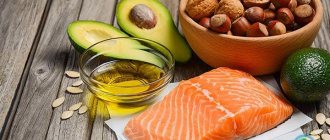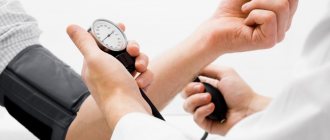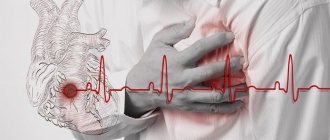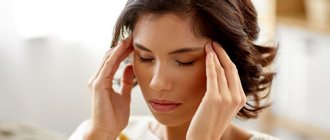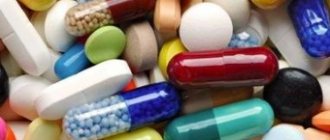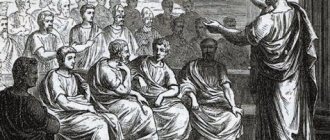Doctors distinguish several types of vegetative-vascular dystonia (VSD):
- cardiac;
- hypotonic type;
- according to the hypertensive type;
- respiratory;
- abdominal;
- mixed.
The cardiac form of VSD is manifested by symptoms of cardiac dysfunction: heart pain, burning in the chest, tachycardia or bradycardia, arrhythmia. Chest pain may resemble pain caused by angina pectoris. In all cases of chest pain due to VSD, doctors at the Yusupov Hospital, using the latest instrumental and laboratory research methods, exclude acute myocardial infarction, stop the vegetative crisis and carry out treatment aimed at preventing heart pain.
Causes of pain in the heart in the cardiac form of VSD
There are several risk factors that can cause cardiac dysfunction in VSD:
- aggravated hereditary predisposition;
- primary deviations in the functioning of the autonomic nervous system;
- emotional and psychological stress.
Chest pain, freezing, heart tremors, neurotic pain in the chest with VSD are caused by the following predisposing factors:
- endocrine diseases;
- neurological disorders;
- fatigue, physical and mental stress.
Doctors at the Yusupov Hospital first establish the cause of the cardiac form of VSD, eliminate it, influence the mechanism of development of symptoms of cardiac dysfunction, and relieve the symptoms of the disease.
Symptoms of the cardiac form of VSD
VSD of the cardiac type is difficult to distinguish from other forms of vegetative-vascular dystonia, since all its varieties are characterized by cardiac disorders. A distinctive feature of VSD is pain in the heart area. How does the heart hurt with VSD? Pain in the heart area during VSD can be pressing, stabbing and burning. The patient experiences discomfort in the chest during an attack. They are similar in nature to signs of coronary heart disease. When examining patients with such complaints, doctors do not detect signs of myocardial infarction or other cardiac pathology.
For heart pain due to VSD, most patients are not helped by nitroglycerin preparations. The lack of a positive result after taking medicinal heart is due to the fact that nitroglycerin lowers blood pressure, the levels of which in VSD are already below normal. Against the background of such effects of cardiac drugs, the patients’ well-being only worsens. Nitroglycerin does not relieve pain associated with myocardial infarction. For this reason, despite the obvious nature of chest pain during VSD, doctors at the Yusupov Hospital must register an electrocardiogram for patients, and patients are advised by a cardiologist.
Symptoms of the cardiac form of VSD can manifest themselves with varying severity. The pain syndrome does not have a clear area of localization; the pain spreads throughout the entire heart and differs in intensity. Patients often note disturbances in the rhythm of the heartbeat, extrasystoles with VSD. They experience a rapid heartbeat (tachycardia). Patients complain of freezing, heart palpitations, and tachycardia after breakfast. A low pulse may be detected with VSD. Nocturnal tachycardia with VSD causes a feeling of fear in patients and can cause a panic attack.
Signs of VSD of the cardiac type intensify in stressful situations and with hormonal changes that occur during puberty in adolescents, as well as in women upon the onset of menopause or when bearing a child.
The course of the disease is accompanied by the periodic occurrence of signs of one of the syndromes:
- cardialgic - aching, stabbing, bursting pain in the chest, burning in the heart area;
- tachycardic – increased heart rate up to 90 beats per minute or more, decreased performance;
- bradycardic – slowing down the heart rate to 60 beats per minute or less, increased sweating, headache, dizziness, malaise;
- arrhythmic - extraordinary cardiac contractions (extrasystoles), heart beats.
Depending on the leading syndrome of the cardiac form of VSD, doctors at the Yusupov Hospital draw up a treatment regimen for the patient. Doctors discuss complex cases of cardiac pathology, manifested by pain in the heart area, changes in heart rate and blood pressure, and extrasystole at a meeting of the Expert Council, in which candidates and doctors of medical sciences take part.
Sinus tachycardia - treatment
Sometimes, a sudden palpitation frightens a person, causing excitement, and accordingly increasing palpitations and tachycardia. This creates a vicious circle that can greatly worsen the quality of life.
In some cases, a combination of palpitations and tachycardia with high anxiety, additional autonomic reactions (sweating, a feeling of lack of air, tremors of the limbs, lightheadedness) cause the patient to fear death and falsely believe that he has a serious, life-threatening disease. In such cases, treatment of sinus tachycardia is carried out with the participation of a psychotherapist.
An objective picture of the state of the cardiovascular system will be provided by studies such as daily Holter ECG monitoring and stress tests (treadmill, bicycle ergometry - ECG with stress).
If there is severe sinus tachycardia, symptoms of any cardiovascular or other disease, then treatment of the underlying pathology is necessary to eliminate it.
If palpitations and tachycardia are repeated quite often or simply cause you severe anxiety, see a cardiologist.
Relief of heart pain during VSD
Therapy for the cardiac form of VSD consists of a set of therapeutic measures in different directions:
- drug treatment;
- power control;
- moderate physical activity;
- normalization of work and rest schedules;
- psychotherapy sessions;
- physiotherapeutic procedures.
Pain in the heart during VSD, symptoms of cardiac dysfunction disappear after taking twenty drops of Corvalol, Valocordin, and motherwort tincture. If the patient is bothered by a slight aching pain in the heart, accompanied by depression, but not affecting physical activity, menthol or regular valerian can be used as a distraction. If burning, prolonged pain of varying intensity occurs, sometimes too strong to endure and requiring emergency care, non-steroidal anti-inflammatory and sedative drugs are taken.
In case of paroxysmal, prolonged pain that occurs unexpectedly, but quickly spreads throughout the chest and is not relieved by taking nitroglycerin, you should immediately call an ambulance. Pain in the heart area that occurs during periods of exacerbation of VSD, which accompanies any physical activity, intense walking and can continue during a period of rest, requires complex therapy. If short-term paroxysmal pain lasts no more than 20 minutes, appearing against the background of emotions or experiences.
Short-acting beta blockers (anaprilin) help with palpitations. They should not be taken if there is severe bradycardia. In this case, belladonna preparations will help. Rhythm disturbances (extrasystoles) with VSD go away on their own. If heartbeats occur frequently and cause discomfort, contact a cardiologist.
To improve the condition and reduce the severity of the symptoms of the disease, it is necessary to positively influence the autonomic system of the body and influence the signs of illness. To achieve the desired effect, the patient is recommended to change lifestyle, attend psychotherapy sessions, take tonics and follow the recommendations of the attending physician.
Any tension of a neurotic nature can be relieved by massage, taking sedatives and sedatives. If there is a fear of death provoked by VSD, psychotherapists work with the patient. Psychoanalysis and Gestalt therapy have a high effectiveness rate. A revolutionary psychotherapeutic method used for VSD is EDMR therapy. It gives amazing results in combination with Ericksonian hypnosis.
Features of treatment and first aid
Having identified symptoms of tachycardia arising from VSD, the patient should consult a cardiologist. The specialist will prescribe a series of examinations to exclude other diseases. After diagnosis, a treatment regimen is drawn up based on the course of the disease. It mainly includes medications, psychotherapy sessions and traditional medicine.
If the attack has already begun, then you need to remember the following algorithm of actions:
- postpone the work being done;
- try to calm down and not think about the bad;
- find a well-ventilated area;
- lie down with a cold object on your forehead.
To get rid of paroxysm faster, the following methods are suitable:
- take quick deep breaths and exhale 2 times slower;
- hold your breath, keeping your abdominal muscles tense;
- lightly press your finger on the root of the tongue to induce vomiting;
- hold your head under running cold water;
- apply force to the angle of the lower jaw;
- use sedative drops (Valerian, Corvalol);
If there is a lack of air, it is recommended to breathe for 10 minutes into a paper bag. If you cannot fight the attack and it progresses, then you need to call an ambulance.
Drug course of treatment
Drug treatment of tachycardia with VSD consists of taking effective sedative and antiarrhythmic drugs. You can see their features below:
- Tablets based on herbs with a sedative effect (hawthorn, motherwort, valerian, peppermint, lemon balm) are inexpensive and publicly available. The effect they have helps reduce nervous tension and normalize pulse and blood pressure. The advantage of such medications is the small number of contraindications and side effects, due to which they are used for a long time. You can purchase herbal preparations at any pharmacy without a doctor's prescription.
- Medicines with a sedative effect, made from chemical compounds, are more effective (Relanum, Prazepam). Doctors recommend using such remedies when you are often in stressful situations. They have an extensive list of adverse reactions, but have a pronounced calming effect, due to which the heart rate decreases and blood pressure stabilizes. Most types of these pills are prescribed by prescription.
- Drugs with an antiarrhythmic effect are used as a means of eliminating tachycardia. They stabilize the heart rhythm and prevent relapses. The downside of these medications is a large number of contraindications.
Medicines from the above groups are prescribed by the attending physician, focusing on the course of the disease. How to get rid of tachycardia during VSD using antiarrhythmic drugs? The following groups will help:
- Beta blockers reduce the effect of adrenaline on the heart muscle by blocking its receptors. They are cardioselective (Betacard, Betoftan, Corbis) and non-selective (Obzidan, Sotalol, Niolol). Medicines from the first group act on beta-1 adrenergic receptors, which are located in the heart muscle. Their blocking contributes to a drop in blood pressure and a decrease in heart rate. Non-selective drugs affect beta-1 and 2 adrenergic receptors. The impact is similar to the first group. The downside of these tablets is the increased risk of developing bronchospasm. In case of VSD, you can limit yourself to cardioselective blockers, since beta-2 receptors are localized in the bronchi and there is no need to affect them.
- Potassium channel blockers prevent the element from entering the heart cells, as a result of which electrical activity slows down, pressure drops and the severity of tachycardia decreases. The most relevant among them is Amiodarone. The drug has a small number of contraindications; it is successfully used to treat arrhythmia and high blood pressure in combination with heart failure. The downside of the drug is the high risk of developing adverse reactions (weakness, decreased visual acuity, thyroid dysfunction) with long-term use.
Medicines with an antiarrhythmic effect are prescribed not to eliminate the cause of the failure, but to stop tachycardia and prevent the development of complications. The following remedies can help reduce nervous tension and improve heart function:
- Nootropic medications (“Piracetam”, “Pantogam”, “Phenibut”) are used to increase the patient’s resistance to stressful situations, physical and mental overload and other external factors. Taking them will improve cognitive abilities and restore the balance between the sympathetic and parasympathetic departments, which will lead to the elimination of the cause of tachycardia.
- Daytime tranquilizers (Prazepam, Trimetozin, Gidazepam) cope well with attacks of panic and unreasonable fear. After taking them, sleep improves and nervous excitability decreases. Unlike simple tranquilizers, medications from this subgroup have a more pronounced anti-anxiety effect and are less sedative and hypnotic. Patients are able to take the medication during the day and do their daily work without causing discomfort drowsiness. By reducing tension in the nervous system, the influence of the sympathetic department is reduced and tachycardia is eliminated.
Frequent paroxysms of tachycardia gradually exhaust the heart. To prevent the development of complications, doctors advise combining sedatives and antiarrhythmic drugs with vitamin complexes:
- "Ascorutin" is rich in ascorbic acid and rutin. It is recommended to be used to normalize metabolic processes, strengthen the walls of blood vessels and the immune system.
- “Napravit” contains a high concentration of B vitamins, magnesium, potassium and other elements vital for the stable functioning of the heart and nervous system. If you take the pills for a long time, you can stop the development of atherosclerosis and complications caused by tachycardia.
- “Asparkam” is valued for the large amount of potassium and magnesium in its composition. Doctors recommend the drug to eliminate arrhythmia, improve cardiac patency and stabilize electrolyte balance. To increase effectiveness, it can be combined with antiarrhythmic drugs.
Psychotherapy
Tachycardia resulting from vegetative-vascular dystonia is effectively eliminated by treating mental problems. Psychotherapy will help solve the problem. Its essence is to improve the emotional state and increase the patient's resistance to stress to prevent attacks. The sessions are conducted by an experienced psychotherapist.
Stabilization of the condition is observed no earlier than the 5th visit to the doctor. In total, it is advisable to undergo at least 10 sessions so that the specialist can reduce the impact of factors affecting the patient’s psyche. In advanced cases, to improve the therapeutic effect, psychotherapy is combined with medications that have a sedative, antiarrhythmic and anti-anxiety effect.
Physiotherapy
Nervous tension, which is often the cause of the development of VSD, can be eliminated using physiotherapy methods:
- acupuncture;
- electropheresis;
- breathing exercises;
- back massage;
- healing baths;
- magnetic laser therapy.
ethnoscience
Increased heart rate caused by vegetative-vascular dystonia can be stopped using traditional medicine methods. They virtually do not cause adverse reactions and have a minimal number of contraindications, therefore they are in demand in the treatment of many pathologies. The list of the most effective recipes is below:
- Hibiscus tea is an aromatic drink made from the Sudanese rose. It has a pronounced sedative effect, due to which the heart rate decreases. Prepare a decoction by pouring 2 buds with 1 cup of boiling water. You can drink 1-2 cups of it every day.
- Collections of medicinal herbs are sold in virtually any pharmacy. They have a sedative, hypotensive and vasodilating effect. You can make the medicine yourself by collecting all the ingredients in the required quantity. To prepare the decoction, you will need to pour 50 g of the collection with 450 ml of boiling water. Take it 50 ml 5 times a day for no more than 1 month.
- The needles are rich in phytoncides, which help reduce blood pressure and eliminate arrhythmia by reducing the heart rate. After completing the course of therapy, patients experience loss of insomnia and increased resistance to stress. You can add pine needles in the form of oils (juniper, pine) to the bath.
- Juniper stabilizes heart function and relieves nervous tension. It is enough to eat 1 berry per day, increasing the dosage by 1 piece. every day. After 2 weeks, take in reverse order. Continue treatment for 28 days.
- Hawthorn decoction can reduce the intensity of manifestations of VSD, reducing blood pressure and heart rate. To prepare, simply mix 30 g of the plant’s fruits with 1 cup of boiling water. Then leave the medicine to infuse. After 20 minutes you can drink it in the morning and evening, ½ cup.
- Honey is a valuable source of B vitamins and other beneficial substances. It can be added to a glass of milk in an amount of 25-30 ml to obtain a good medicine with a sedative effect. It is best to drink it before bed.
Prevention
Compliance with the rules of prevention will prevent the development of further attacks of tachycardia and improve the general condition. Their list is below:
- devote at least 7-8 hours of sleep a day;
- periodically take 5-minute breaks at work;
- adjust the daily menu;
- try to avoid conflicts;
- apply self-hypnosis techniques;
- exercise.
Tachycardia, manifested against the background of VSD, occurs quite often, especially in the presence of disruptions in the nervous and endocrine systems. Its sinus variety does not require special treatment, but more serious forms must be identified immediately so that they do not lead to the development of severe complications. Arrhythmia can be reduced with medications, folk remedies and psychotherapy sessions. The doctor should select a course of treatment, focusing on the main cause of the failure in the autonomic nervous system.
Prevention of attacks of heart pain during VSD
Heart pain, fading, and tremors of the heart during VSD do not threaten the patient’s life. Sometimes the attack lasts for several days, but is well treated with validol and sedatives. If discomfort in the chest increases, or a feeling of cardiac arrest occurs during VSD, the patient is provided with rest, a comfortable body position, fresh air and sedatives. If a connection is noticed between increased pain in the chest during deep exhalation and inhalation, the patient is taught to normalize breathing using breathing exercises.
To minimize the risk of recurrence of attacks of pain in the heart during VSD, patients are advised to adjust their lifestyle:
- Sleep at least eight hours a day;
- Regularly engage in physical labor of moderate intensity;
- If your professional activity requires a sitting position, you should do gymnastics 1-3 times a day;
- Eat as natural a diet as possible with a predominance of raw vegetables and fruits;
- Eliminate psycho-emotional stress, learn to have a neutral attitude towards failures and problems;
- Get regular check-ups with a cardiologist.
If you have heart pain, nocturnal tachycardia, increased heart rate after eating and other signs of VSD, call +7. Doctors at the Yusupov Hospital will relieve an attack of heart pain and other symptoms of VSD and will provide comprehensive treatment aimed at preventing vegetative-vascular cardiac crises. In the rehabilitation clinic, patients are individually selected the most effective physiotherapeutic procedures, gymnastic exercises, and are taught breathing exercises. Psychotherapists use innovative methods to support the patient during an attack of pain and in the inter-attack period.
